David S. Ferriero's Blog
April 20, 2022
Laying a Wreath at Arlington
This week I had the honor of laying a wreath at the Tomb of the Unknown Soldier at Arlington National Cemetery on behalf of all of us who work here at the National Archives and Records Administration. The invitation came from Tim Franks, Historian at Arlington, who has been a friend for many years through his research in our cemetery records.
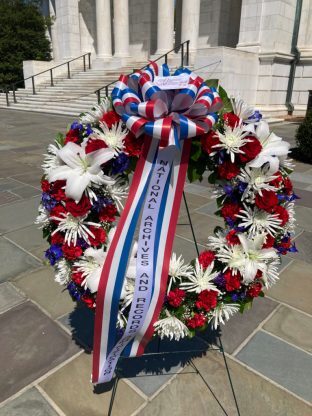
It was a special invitation because Tim knows how much I have come to love and respect that space. Early on in my time here, I walked over to Arlington and wandered the paths. It quickly became my destination for peaceful reflection and solace. Stepping through the gates of the cemetery gave me the same feeling I get on a sailboat when leaving land behind—all the cares of the world are left on shore and ahead is tranquil space for thinking.
My times at Arlington have included the annual wreath laying during the holidays. Three particular graves always got my attention—William Henry Christman, the first burial at Arlington was a 19 year old Civil War soldier who died of measles before seeing action in the war; Arthur Halligan, the World War II, Korea, and Vietnam veteran father of a New York Public Library colleague; and Admiral Chester L. Harding, Commandant of the First Coast Guard District, and the father of a high school friend. Those graves are in three very different parts of Arlington, giving me yet another opportunity to reflect on the lives of those buried on my path.
Christman’s grave is on the edge of that part of Arlington which was the Freedman’s Village, a community of previously enslaved people. Almost 4,000 of them are interred in this section of the cemetery and unlike most of the other headstones, these contain scant information about the individuals. We have in our holdings an early map of the Freedman’s Village and when I am in Section 27 of the cemetery, I try to imagine life during that time.
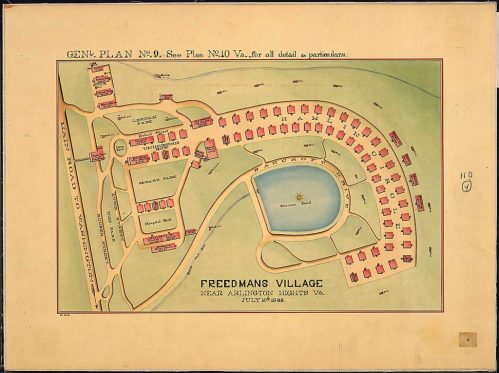 Map of the Arlington Freedman’s Village, July 10, 1865.
National Archives Identifier 305826
Map of the Arlington Freedman’s Village, July 10, 1865.
National Archives Identifier 305826
So, Arlington has become a special place for me and being asked to place a wreath at the Tomb was an unexpected and appropriate way to end my time here. Standing at the top of the steps waiting for the Changing of the Guard ceremony to end, my thoughts turned to all those buried at Arlington, the sacrifices they made for our country, and the fact that I made it back alive. Those of us who have served, especially in a war zone, suffer some form of survivor guilt, questioning why we were spared. Those thoughts accompanied me down the steps to grasp the wreath, inhale the fragrance of the white lilies, and say a prayer as I placed the wreath at the Tomb.
Thanks to all of them for their service.
 Archivist of the United States David Ferriero lays a wreath at the Tomb of the Unknown Soldier on Monday April 18, 2022.
Archivist of the United States David Ferriero lays a wreath at the Tomb of the Unknown Soldier on Monday April 18, 2022.
April 15, 2022
Learning and Growing with the Library and Archival Community
Last year, OCLC’s Rachel Frick and Merrilee Proffitt convened a group of experts, practitioners, and community members to discuss reparative and inclusive descriptive practices, tools, infrastructure, and workflows in libraries and archives. Staff from the National Archives participated and were energized by the conversations. Last week, OCLC published a report based on the convening, “Reimagine Descriptive Workflows: A Community Informed Agenda for Reparative and Inclusive Descriptive Practice.” The report helpfully frames the challenges to consider when working on inclusive and reparative metadata work.
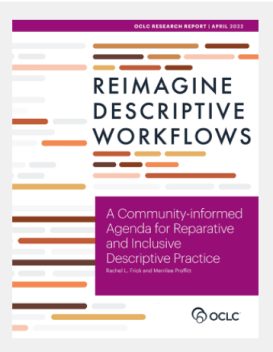
The report is a must-read if you have an interest in the archival profession. Three particular points made in the report have resonated deeply with the reparative description and digitization work we are doing at the National Archives:
It Takes Time to Build Trust
OCLC notes that building trust is a key element of reparative and inclusive description work:
Trust is built between organizations and communities through experiences, and it is diminished or increased with each interaction. Trust is cumulative and communicated in every action. (OCLC, p. 16)
Over the past year, NARA’s Reparative Description and Digitization Working Group has developed a process for building relationships with communities. This entails working within the Agency to identify our own experts on specific communities. Getting advice from our internal experts about whom we should contact in external communities. Meeting with external community contacts to discuss their community’s relationship (or lack of) with the National Archives and listening to their recommendations for reparative description, transcription, and digitization efforts.
In the past, we might have just leaped into the work at that point and started doing what we thought we heard from the community contacts (if we had contacted them at all). But with our current focus on building relationships and trust, we decided to work up potential projects based on what we heard from the community contacts and then meet again with them to confirm – are we on the right path? Did we understand you correctly? Do our priorities reflect your intentions?
What we have found is that the community contacts are somewhat surprised that we contacted them again and pleased that we not only listened to them, but actually did some follow up work. This is not a fast process and it is not “one and done.” We will continue meeting with community contacts as we work through projects that are useful to them. In this way, NARA intends to become more inclusive and to build ongoing trust with our users.
The OCLC report confirms this approach:
Relationship building, communication, and developing a shared understanding in the reparative and inclusive description space should not be rushed if the ultimate goal is to open up descriptive practice to be inclusive by building trust and reciprocal relationships with contributing communities. (OCLC, p. 6)
This process takes time, which can be somewhat alarming when we look at the scale of work in front of us. But this time is critical to take. OCLC notes:
The urgency to address past harms and correct harmful behaviors and workflows must be tempered by proceeding at a speed that supports building trust, promotes continuous learning, and embraces iterative effort. The work of reparative and inclusive metadata will never be finished. Stewarding the data about library and archive collections for users today and into the future will require ongoing refinement to practice (OCLC, p. vi).
Actions Speak Louder than Words
With the Archivist’s Task Force Report on Racism and our Potentially Harmful Content Statement, NARA acknowledges systemic racism and exclusive practices in our archival work. This is a critical first step, but must be followed by action. The OCLC report notes, “…acknowledgement and apologies are not substitutes for redress…” (OCLC, p. 7).
Staff from across NARA as well as the Reparative Description and Digitization Working Group have been attending pertinent Society of American Archivists webinars and training sessions to learn from our peers who are doing similar work. We have also invited experts to speak with us so we may learn from their work. We know that NARA is one part of a larger archival community that is learning to address systemic racism in our work.
OCLC notes, “All institutions (and individuals working within institutions) can and should consider the power they hold and their ability to dream and enact change. Not taking any action perpetuates the status quo.” (OCLC, p. 15). NARA’s working group is in the process of developing concrete approaches to enable reimagined descriptive metadata practices. This includes updating our Agency’s description training, standards, and review processes to embed guidance on reparative terminology and descriptive practices into our core description workflow. As we begin to make progress on these efforts, we are determined to be transparent by posting milestones to our Reparative Description and Digitization webpage.
Our Responsibility as a Power-Holding Institution
OCLC’s report notes, “Institutions such as government bodies, schools, churches, libraries, archives, and other organizations that serve communities are entrusted with considerable power to act responsibly on behalf of society. Typically, the larger (in wealth, status, profile) the organization, the more power it wields. ” (OCLC, p. 15)
At the National Archives, we recognize the important position our institution holds as we preserve and provide access to the permanent records of the federal government. We do not take our position lightly and we are committed to continually learning and growing with the archival community.
The values expressed by libraries, archives, and related fields of knowledge aim to affirm the desire to welcome and embrace all peoples. The information communities of practice have embraced this set of values while continuing to operate using systems and structures that were developed during the nineteenth century and reflect a Western white male hegemony. These current systems and structures do not support the kaleidoscope of races, ethnicities, genders, sexual orientation, religions, abilities, and more that are reflected in the communities that are served by libraries and archives today. By applying white-centered, Western concepts to items representing a wider, diverse world view, there is the risk of hiding knowledge in plain sight. A user familiar with terms based in their communities’ culture and knowledge may never connect to objects described using terms based on the dominant culture, effectively silencing these diverse voices in collections. (OCLC, p. 9)
This is the work of archives going forward, to repair the description of our historical records, to listen to those who have been silenced, and to center those who have been marginalized. By doing so, we improve and expand access to the records and provide a fuller understanding of our history for all Americans.
For Further Information:
Frick, Rachel L., and Merrilee Proffitt. 2022. Reimagine Descriptive Workflows: A Community-informed Agenda for Reparative and Inclusive Descriptive Practice. Dublin, OH: OCLC Research. https://doi.org/10.25333/wd4b-bs51Cataloging Lab’s List of Statements on Bias in Library and Archives DescriptionApril 7, 2022
This Week in the 1950 Census
It’s been a very good week for the 1950 Census! Our goal for the 1950 Census website was to provide a simple, intuitive site as well as bulk download capabilities for users and make it available as soon as we legally could. The National Archives’ Census team stayed up late on the evening of March 31st to launch the 1950 Census at the stroke of midnight. Immediately, people from around the world began logging on to the 1950 Census website and downloading the records.
In this first week, we have had more than one million users and more than 37 million page views on the website. It’s a good thing we optimized the site for mobile because almost half of our users, 48%, used their mobile devices to access our site. I am also pleased to see that several other websites have used our bulk download option and are creating their own access to the 1950 Census.
More than 96% of our users are from the United States, the rest of the top ten geographic locations of our users are: Canada, UK, Ireland, Germany, Australia, Puerto Rico, France, Sweden, and Mexico.
This week, our launch of the 1950 Census has been written about in the Washington Post, The New York Times, the Boston Globe, and hundreds of news outlets across the country and around the world. Helpful blogs were posted soon after launch, such as Time Travel with NARA, by Judy G. Russell.
Staff were most gratified to see comments across the web from people who talked about finding their families:
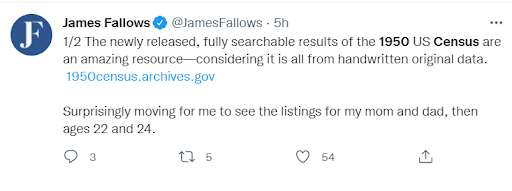
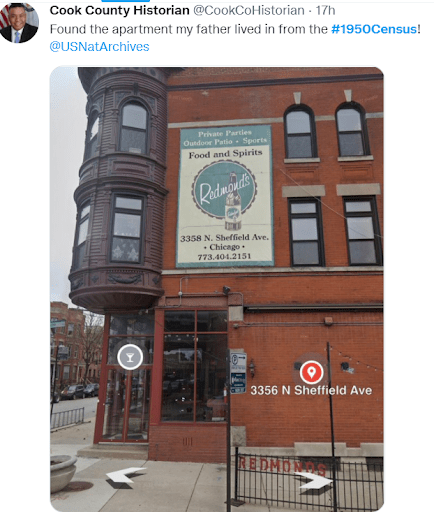

People also found celebrities including Elvis, Muddy Waters, Andy Warhol, Bob Dylan, and Jimmy Stewart.
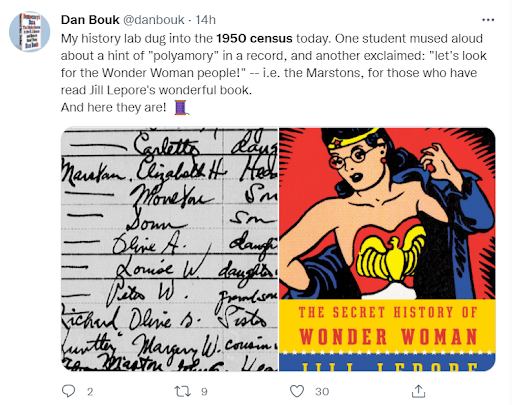
Chicago Sun Times journalist, Neil Steinberg wrote about the joys of searching the 1950 Census in Tracking down the family and the famous.
I want to thank so many NARA staff, many of whom have worked on the 1950 Census project for years. And my thanks to the public volunteers who are transcribing the name index to make our 1950 Census website more searchable. Want to help out? Jump on to the 1950 Census website and start transcribing! Help us bring the past to future generations.
More Tweets we loved:
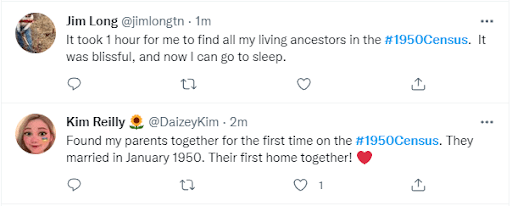





April 1, 2022
The 1950 Census is Here!
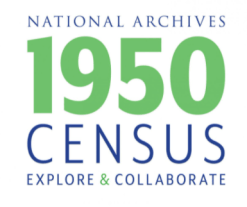
At midnight, the National Archives launched the 1950 Census website.
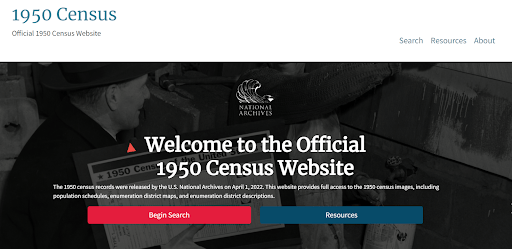
Staff from across the agency have been working over the past decade to prepare the records and provide them to you. I am very proud of how their work has fulfilled our mission to make access happen.
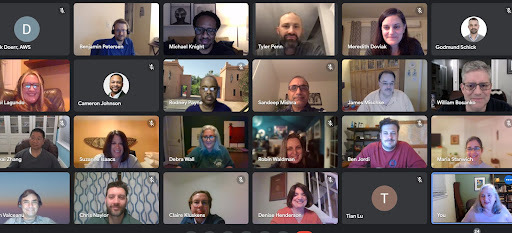 NARA and Amazon Web Services experts working together on the night of the launch. These are just a few of the many NARA staff who have worked on the Census.
NARA and Amazon Web Services experts working together on the night of the launch. These are just a few of the many NARA staff who have worked on the Census. This is the first census that I make an appearance in. Earlier this morning I I used the search tips on the homepage to locate my family:
Search for the first and last name of the head of household (plus state and county of residence if known) because the surname was written on the census form only on the line for the head of household and other persons in the household with a different surname.
Since my father Anthony was the head of our household, I searched using his first and last name, I also entered “Essex County” and “Massachusetts.” That includes the town I grew up in, Beverly.
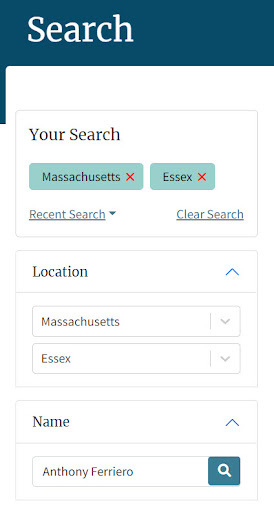
And I found the population schedule that listed my family:
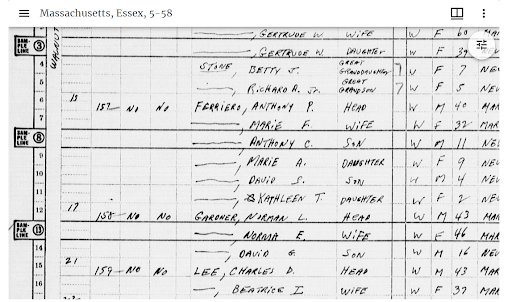 1950 Census population schedule Massachusetts, Essex, 5-58
1950 Census population schedule Massachusetts, Essex, 5-58
This Census shows my father Anthony, my mother Marie, and my siblings Anthony, Marie and Kathleen. The Census also indicates that I was four years old when it was taken and I still remember the Census Enumerator who came to our door. Her garter belt had broken and she asked my mother for a penny to repair it!
 David Ferriero in Beverly, Massachusetts, circa 1950
David Ferriero in Beverly, Massachusetts, circa 1950Follow #1950 Census on Twitter and you will see that many others have been finding their families in the Census as well!
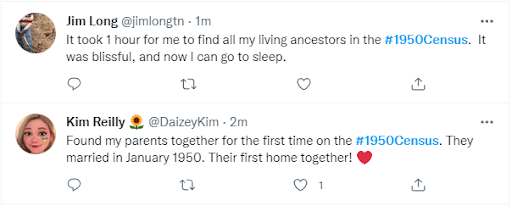
My father was one of 13 children, all lived in or around Beverly, Massachusetts, in 1950. I will be looking through this Census for them today. I hope you will join me in celebrating this achievement and take a few moments to search the Census for your loved ones.
For more information, visit the homepage of the 1950 Census .
March 14, 2022
By the Numbers: 2010-2022
Numbers never tell the whole story, but they do provide insights that are useful for understanding the scope and impact of our work. Here are some of the numbers we have tracked that indicate how we have grown to make access happen, connect with customers, and maximize our value to the nation from 2010 to 2022.
When I first came to NARA, I shared with staff the great Wayne Gretsky quote, “skate to where the puck is going to be.” I asked, “Where are the people going to be online?” In 2010, it was social media. People who may never come to our buildings or even our website, could come across our records on Facebook, Twitter or a blog. And so on April 7, 2010, I launched this blog and encouraged NARA staff to give social media a try. Since then, I have published 416 posts over the years, and they have had an average of over 50 thousand views per year. We launched three more social media projects in 2010 and NARA’s work in social media blossomed from there. By 2107, we had 165 social media accounts on 16 platforms receiving millions of views, and today social media has become a routine part of NARA staff duties and operations.
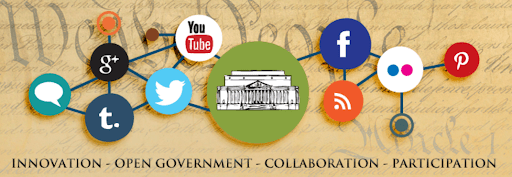
One of the most popular and unusual social media accounts we have had is on the GIPHY website. The staff’s combination of technical knowledge and their love of the archival records made this project into a hit. We launched in 2016 and since then, our records have received a total of more than four billion views from around the world.
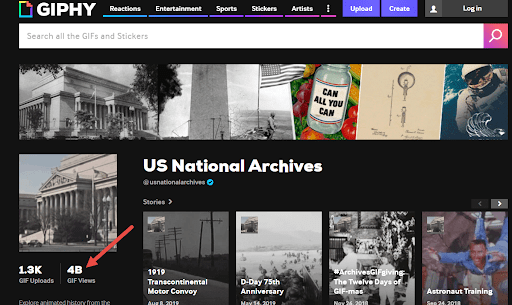 https://giphy.com/usnationalarchives
https://giphy.com/usnationalarchives
The people also go to Wikipedia. In 2011 I hired NARA’s first Wikipedian-in-Residence who worked with the local Wikipedian community to ensure that our records were available on their website. The results were phenomenal. NARA records received 1,274,493,206 views on Wikipedia in 2013, and the numbers kept climbing; by 2021, we received 2,110,071,649 views. Compare this to our archives.gov site, which received 29,351,833 views in 2013 and grew to 231,551,478 views in 2021. Impressive numbers for our website, but nothing like the turbo power of Wikipedia for getting views. NARA now provides data and digital copies of our records to numerous Wikimedia sites, including Wikimedia Commons and Wikidata.
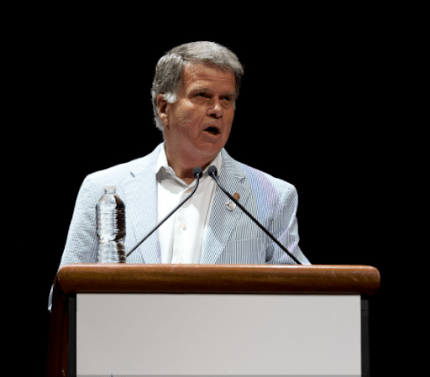 David Ferriero, 10th archivist of the United States of America, during the closing session of wikimania 2012, July 14th, 2012.
David Ferriero, 10th archivist of the United States of America, during the closing session of wikimania 2012, July 14th, 2012.
The well from which we draw our metadata and digital objects for our digital public access projects is the National Archives Catalog. The Catalog provides descriptions for over 95% of our holdings. So you do not need to come to our buildings to learn about the records we hold, you can see descriptions of our holdings online. In 2010, the National Archives Catalog had 5,195,538 descriptions. In 2021 the Catalog provided 27,789,076 descriptions.
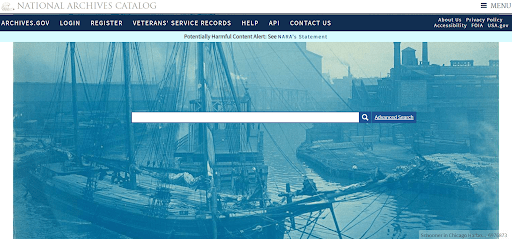
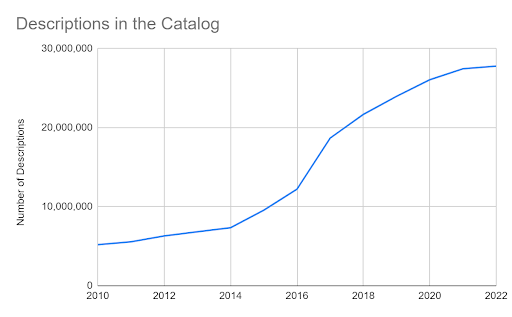
We know that providing digital copies of our records democratizes access to our records. We have dramatically increased the digital copies in our Catalog. In 2010, the Catalog had 157,020 digital objects and now provides 168,793,975 digital objects.
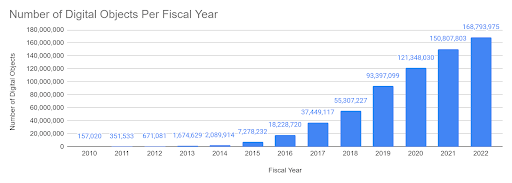
The 10 Most Viewed Records in the Catalog in 2021:
Engrossed Declaration of Independence (NAID 1419123)Constitution of the United States (NAID 1667751)Population Schedules for the 1910 Census, 1910 – 1910 (NAID 2353588)Bill of Rights (NAID 1408042)The Final Rolls of Citizens and Freedmen of the Five Civilized Tribes in Indian Territory (NAID 300321)Index to the Final Rolls of Citizens and Freedmen of the Five Civilized Tribes in Indian Territory (NAID 300320)Emancipation Proclamation (NAID 299998)Population Schedules for the 1940 Census (NAID 16660414)Corporation of the City of Washington, D.C. 1802-6/1/1871 (NAID 10488163)Engrossed Dockets, 1791 – 1995 (NAID 1524561)The result of our digitization work has been a dramatic increase in page views as well.
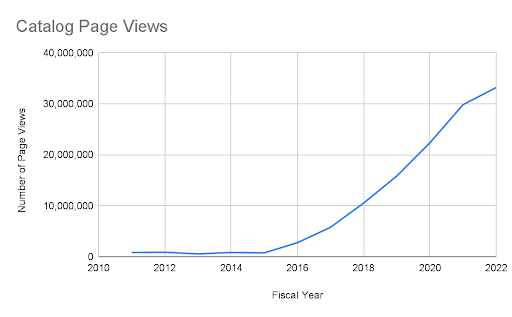
In the last quarter of 2015, I opened the Innovation Hub at our flagship location in Washington, D.C. This is a place intended to support staff to work collaboratively with the public. We have had 6,817 visitors to the event space and 3,375 visitors to the scanning room, for a total of 10,192 visitors in-person since we opened. We have uploaded 598,680 pages to the Catalog that were scanned by the public in the Innovation Hub. Some files also have a PDF compilation, bringing the total number of digital objects to 613,117 in the Catalog.
 David Ferriero scanning NARA’s records in the Innovation Hub, 2018.
David Ferriero scanning NARA’s records in the Innovation Hub, 2018. We launched the digital History Hub platform in 2016. The goal of this website has been to provide digital reference to the public and to crowdsource responses from NARA staff and the public. The History Hub started its first year with 1,713 registered users in FY16 and grew to 11,391 users by FY21. The Hub platform grew from 373 questions and answers in FY16 to 3,692 questions and answers in FY21. A comment from one of our users: History Hub is amazing and I am so grateful for this site and for the people like you who help people like me find answers to the questions we have. The platform became a critical reference tool during the pandemic, when staff and the public could not go into our buildings.
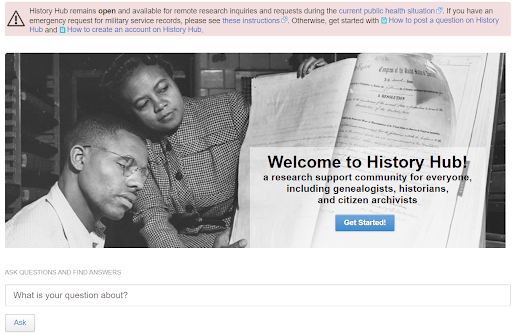
We have also reached out to other websites to share our records. NARA has supported the Digital Public Library of America since its inception in 2011. We co-hosted their 2015 annual conference along with the Smithsonian and Library of Congress. Today NARA is the largest contributor to DPLA’s online platform.
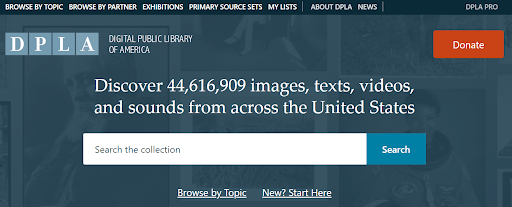
Substantial numbers of NARA’s records are now available across 37 platforms beyond our archives.gov websites. One is of particular note: our work with the DigiTreaties.org, which won the 2021 Society of American Archivists’ C.F.W. Coker Award for Description and provides access to 374 of the Ratified Indian Treaties from NARA’s holdings.
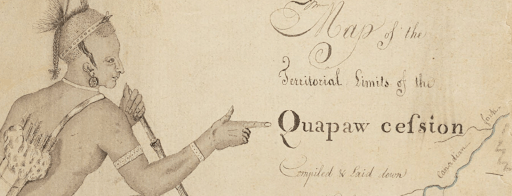 Ratified Indian Treaty #96
, between the United States and the Quapaw Indians, signed at St. Louis on August 24, 1818, contains a hand drawn sketch/map.
Ratified Indian Treaty #96
, between the United States and the Quapaw Indians, signed at St. Louis on August 24, 1818, contains a hand drawn sketch/map.One of our largest access projects to date is the development and launch of the 1950 Census website. NARA staff from across the Agency have been working since 2012 to prepare for the April 1, 2022 launch of the 1950 Census website.
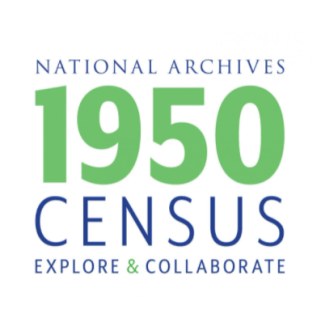
The site includes: 6.57 million population schedules, 33,360 Native American Reservation Schedules, and 9,634 maps. This is approximately twice the size of the 1940 Census. We know that the number of views on April 1 is going to be enormous and we are scaling our technology to handle the many millions of visits we expect to receive.
These numbers reflect only a few highlights of the work that has been accomplished since 2010. NARA staff around the country are working on many more projects that support our mission to provide public access to the permanent records of the federal government. All of our efforts are in alignment with our values to collaborate, innovate, and learn.
Previous By The Numbers posts:
By The Numbers 2020
By the Numbers 2019
By the Numbers: Digitization and Citizen Engagement
By the Numbers: Connecting with Customers
By the Numbers: Maximizing Value Through Web and Social Media
March 10, 2022
Celebrate Sunshine Week with the National Archives
Each year, Sunshine Week honors and promotes a dialogue about the importance of open government, access to information, and unnecessary secrecy—values that are central to the mission of the National Archives and Records Administration.
More than 100 years ago, Justice Louis Brandeis wrote: “Sunlight is said to be the best disinfectant. If the broad light of day could be let in upon men’s actions, it would purify them as the sun disinfects.” I like to think that we celebrate Sunshine Week every week at the National Archives.

This year, I am pleased to kick off Sunshine Week with a conversation alongside Librarian of Congress Dr. Carla Hayden, moderated by Philanthropist David M. Rubenstein, a generous supporter of both the National Archives and the Library of Congress.
The conversation will take place from 1:00 p.m. to 2:30 p.m. Monday, March 14, and will be live-streamed on the National Archives YouTube Channel. Dr. Hayden and I discussed accessing our nation’s treasures during the 2017 celebration of Sunshine Week at the National Archives. So much has changed in the five years since—a global pandemic, civil unrest, and renewed societal interest in issues surrounding diversity, equity, and inclusion.
If you have suggested questions for the panel discussion, please tweet them to @FOIA_ombuds using the hashtag #SunshineWeek.
We have also invited U.S. Senator Patrick Leahy and Chief Judge Beryl A. Howell of the US District Court for the District of Columbia to join us for this celebration of FOIA. Sen. Leahy’s and Judge Howell’s mark on the Freedom of Information Act (FOIA) dates back to the 1974 amendments to the law, which provides a right of access to federal agency records. Several short videos on the meaning of open government and transparency also will be featured.
This will be my last Sunshine Week as Archivist of the United States before I retire in April. We hope you’ll join us! View the livestream on the National Archives’ YouTube Channel.
More information about this year’s event is available on the Sunshine Week website. To learn more about OGIS’s work, visit their web page or follow the FOIA Ombudsman blog.
March 1, 2022
Countdown to the 1950 Census!
The clock is ticking down to the April 1, 2022 launch of the 1950 Census and NARA staff have been buzzing with activity in preparation for the date.
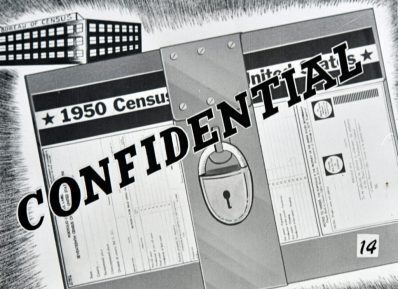 The Big Count
National Archives Identifier 178688266
, p. 15
The Big Count
National Archives Identifier 178688266
, p. 15The data for each Census is restricted for 72 years, and the earliest it may be made available for this census is April 1, 2022. And by the way, this is the first U.S. Census where I make an appearance! NARA is planning to make the Census available that day. As we work with the records, our estimates for the files get more refined. We currently estimate that the 1950 Census includes 6.57 million population schedules, 33,360 Indian Reservation Schedules, and 9,634 maps. This is approximately twice the size of the 1940 Census.
Please note: the link to the 1950 Census database will be available on this page on April 1.
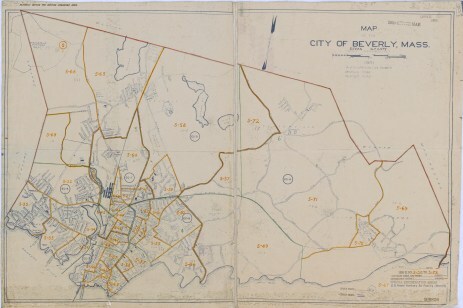 1950 Census Enumeration District Maps – Massachusetts (MA) – Essex County – Beverly – ED 5-30 to 72.
National Archives Identifier 12171704
1950 Census Enumeration District Maps – Massachusetts (MA) – Essex County – Beverly – ED 5-30 to 72.
National Archives Identifier 12171704
NARA is trying new approaches to offering this Census:
This is the first time NARA is able to make the Census digitally available through a name-searchable database. In the past, people were required to use enumeration district maps to search for records on our website. This is the first time NARA has used a machine-learning empowered OCR tool to create a draft name index that will be available on the first day of the Census opening. We know that the index will not be perfect, so we are asking for your help to refine it. This is the first time NARA is making available a transcription tool for the Census so that you can help us improve the name index. We thank you in advance for your support!
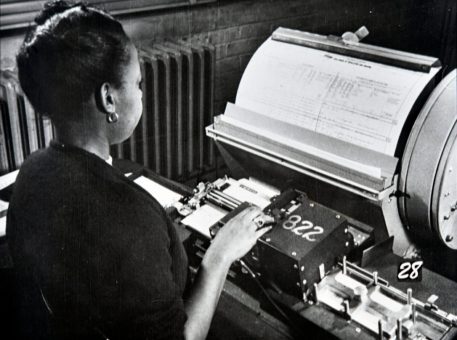 The Big Count,
National Archives Identifier 178688266
, p. 29
The Big Count,
National Archives Identifier 178688266
, p. 29This is the first time NARA is making bulk download of the records available free for anyone who would like to use the data on their website (for example, genealogy sites) or mine the entire body of data for information (for example, social scientists). Both the website and the bulk download will be available on the first day of the Census opening.
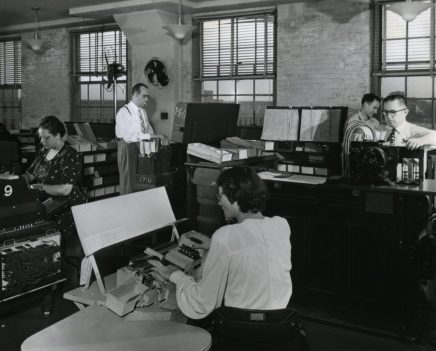 Photograph of the 1950 Census Being Tabulated, ca. 1950,
National Archives Identifier 207527227
Photograph of the 1950 Census Being Tabulated, ca. 1950,
National Archives Identifier 207527227
NARA staff, including archives and IT specialists, project managers, and communications staff are all focused on ensuring that you have access to the 1950 Census on April 1. I appreciate the extraordinary efforts they have taken to fulfill our strategic goal to make access happen.
 The Big Count
National Archives Identifier 178688266
, p. 10
The Big Count
National Archives Identifier 178688266
, p. 10
February 23, 2022
Meeting You Where You Are
Over the years, NARA’s GIPHY Channel has been surprisingly popular with the public. We first launched our channel on GIPHY in 2016, not knowing if the public would be interested in this way of sharing our records. We quickly learned that we were on to something when we received nearly 32 million views that year. By the end of 2020, we had a total of 2.3 billion views. In 2021, our GIFS received another 1.7 billion views, for a cumulative total of over 4 billion views for this project and counting. This is an astonishing number that eclipses the views of our records on all of our other platforms, except for our records on Wikipedia, which routinely achieve one billion views annually.
The GIPHY platform is particularly popular with younger adults, many who may never come to our archives.gov website. This is an inexpensive way for us to move our records out into the culture in ways we had not done previously. The platform is free to use and NARA staff are technically adept at creating GIFs. They have fun making them, too. Over the years, NARA experts have been invited to train staff at other government agencies and cultural heritage institutions to use GIPHY as well.
Here’s a look at the most popular Archives GIFs from 2021 and some of the reasons they were trending:
RankThumbnailTitleBackground1 Iwo Jima Flag Raising
Iwo Jima Flag Raising52.4 Million Views in 2021One of the most iconic scenes in American history, this footage of the flag raising during the Battle of Iwo Jima is often associated with trends around the American Flag, the Marine Corps, and World War II.2
 Backcountry Skiers
Backcountry Skiers46.7 Million Views in 2021A popular winter-themed GIF, these intrepid backcountry skiers are part of an avalanche scouting party in the Canadian Rockies, and featured in a Universal News newsreel from the 1950s.3
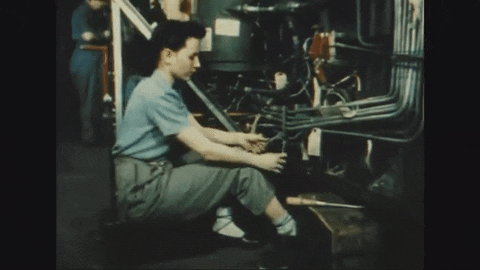 Wartime Woman Mechanic
Wartime Woman Mechanic42.9 Million Views in 2021This industrious mechanic was featured in the Ford Motor Company’s World War II-era film “Women on the Warpath,” showcasing women’s contribution to the war effort. An evergreen favorite, it is particularly popular during March’s Women’s History Month.4
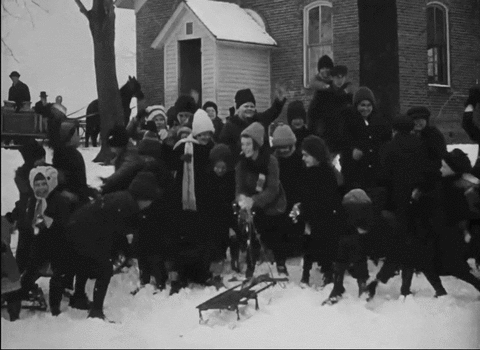 Vintage Snowball Fight
Vintage Snowball Fight37.6 Million Views in 2021Excerpted from Henry Ford’s early 1900s “Mirror of America,” it’s not hard to see why this vintage schoolyard snowball battle always trends whenever a Twitter #snowballfight breaks out.5
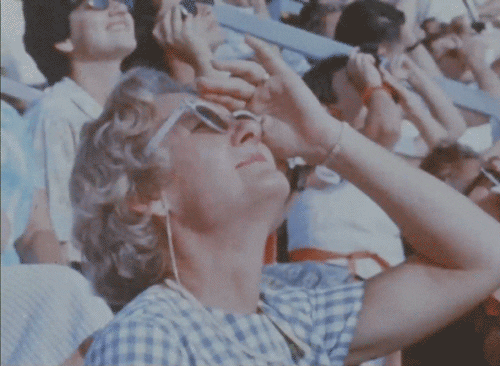 Rocket Launch Spectator
Rocket Launch Spectator36.4 Million Views in 2021This captivated spectator was featured in NASA’s retrospective “America in Space – The First Decade.” Several private space launches this year helped catapult this GIF to the #5 spot for the year.6
 Dancing Dogs
Dancing Dogs33.9 Million Views in 2021Trained dogs “Waffles” and “Dumpsie” have been perennial favorites ever since our GIPHY channel launched back in 2016 and continue to hold the #1 all-time spot.7
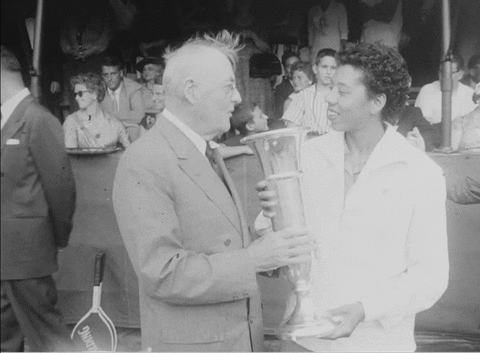 Althea Gibson
Althea Gibson33.5 Million Views in 2021The top GIF for Women’s History Month in March, tennis pioneer Althea Gibson receives the trophy for women’s singles at the 1958 U.S. National Championship (now the US Open).8
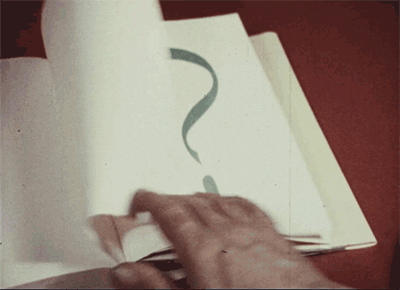 Book of Question Marks
Book of Question Marks30.3 Million Views in 2021“The Day the Books Went Blank” was a 1960s PSA on the value of a strong public library system, produced by a consortium of New England Libraries. It provides the source for a number of compelling images, including this enigmatic book of question marks. It remains one of our all-time popular GIFs, second only to Waffles & Dumpsie.9
 Weary Couple from the 1963 March on Washington
Weary Couple from the 1963 March on Washington24.6 Million Views in 2021The sense of exhaustion and accomplishment is almost palpable in this scene from the end of Martin Luther King’s 1963 March on Washington. Not surprisingly, it’s most popular during February’s Black History Month.10
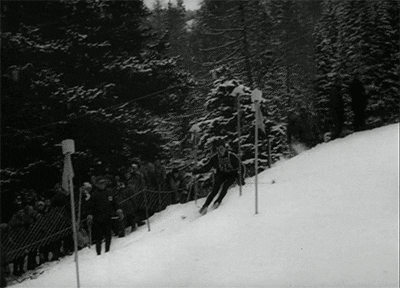 Olympic Downhill Slalom
Olympic Downhill Slalom21.1 Million Views in 2021Jimmy Heuga “dances through the gates” to win the bronze medal in the Men’s Slalom at the 1964 Winter Olympics.
See some of our past blog posts about Archives GIFs and don’t forget to visit our GIPHY channel!
February 17, 2022
Consistently Customer Centered
The current administration has called on federal agencies to focus on transforming federal customer experience. In response, the National Archives is embedding customer experience initiatives and principles into the strategic goals for the agency. We are also developing an agency-wide customer experience program. As exciting and energizing as our new efforts are, focusing on customer experience is not new to the Agency. Cultivating public participation and access to our records has always been fundamental to our mission.
Several years ago, NARA web staff participated in the OPM Center for Leadership’s training for User Experience (UX) and human-centered design. We also brought on a new web designer who is skilled in UX practices and human-centered design principles. NARA published our first digital personas in 2017 as part of our web and social media research. We have since updated our personas and will continue to do so as our understanding of our customers evolves. During NARA’s joint conference with Virginia Tech last year, we developed a list of 92 user stories (see pages 26-32). As NARA’s web staff have developed experience and expertise with human-centered design, the team has offered consultation, training, and technical assistance to other staff throughout NARA who have sought to make improvements to the user experience of their web content.
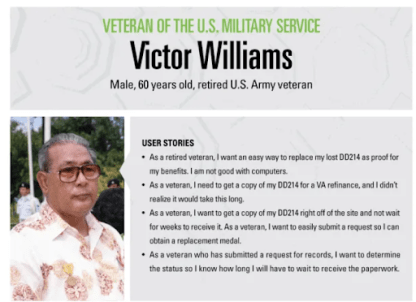 An example of one of NARA’s personas.
An example of one of NARA’s personas.One of the most critical projects that the agency is currently working on is the launch of the 1950 Census. For the past year, our staff have been focused on user research and design for the website that will be launched on April 1. The team conducted user research interviews with internal and external stakeholders and through the interviews they were able to identify specific design and functional requirements that were vital in order to best meet the needs of our customers. In addition, members of our web team designed the wireframes and mockups which were used to develop the visual layout of the 1950 Census website.
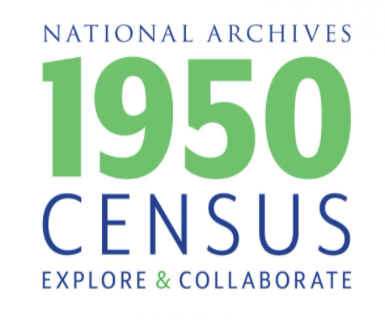
NARA staff continue to learn and attend UX trainings, the most recent include: “Participatory Design,” “Designing Accessible Communications,” “Problem-Framing for Solution-Finding,” “UX Certification Program,” the “Government User Experience Summit,” and “Human-Centered Design Fundamentals.”
How You Can Help
Currently, we are looking for feedback from interested Catalog users of all levels to help us create the Next Generation Catalog. Also we are seeking users and developers for input on the new Catalog application programming interface (API). If you choose to sign up, we may contact you in the future to optionally participate in activities like focus groups, usability tests, and more. It’s an exciting way to shape the future of the National Archives Catalog!

Interested in participating? Please complete our survey to share your experiences with the Catalog and to be placed on a list to learn more about upcoming user research opportunities.
There is no obligation to participate, and you can request to be removed from the list at any time. The survey will be open until February 28, 2022. Thank you for helping us to maintain our focus on your user experience.
February 8, 2022
DEIA at NARA
Diversity, Equity, Inclusion, and Accessibility at the National Archives and Records Administration
The White House recently released a government-wide Strategic Plan to Advance Diversity, Equity, Inclusion, and Accessibility (DEIA) for the federal workforce. NARA will use this plan to develop an agency-specific DEIA Strategic Plan in spring 2022. This Strategic Plan follows President Biden’s Executive Order (E.O.) 14035: Diversity, Equity, Inclusion, and Accessibility in the Federal Workforce, which directed the establishment of a systematic approach to embed DEIA in agency talent practices, workforce engagements, and organizational structures.
The work of my Task Force on Racism and its recommendations have laid the groundwork for our E.O. 14035 activities, much as they positioned NARA for success on E.O. 13985, Advancing Racial Equity and Support for Underserved Communities Through the Federal Government.
NARA will use this framework to advance many of the recommendations of the Task Force, including:
Recruiting, hiring, and retaining a diverse workforce by enhancing outreach strategies, reinvigorating internship programs, and by providing developmental opportunities and training that supports equitable career advancement and improves supervisory effectiveness. Establishing diverse leadership pipelines by standardizing position descriptions, developing a succession planning process, and creating agency-wide roadmaps to ensure equitable compensation, methods to cultivate qualified internal candidates for future vacancies, and career development opportunities.Developing a robust DEIA program that educates the workforce on DEIA concepts, promotes a culture of inclusion and professionalism, and drives a sense of belonging for all current and future employees.At NARA, people are at the center of everything we do. We are committed to working together as an agency to develop a diverse workforce that is inclusive in its interactions, equitable in its practices, and accessible to all current and future employees.
David S. Ferriero's Blog



